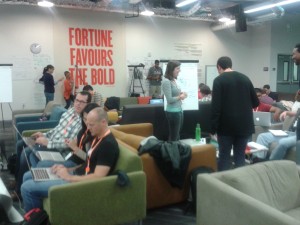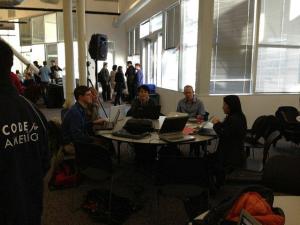Since SXSWedu, a number of bloggers have raised questions about why there aren’t more educators at ed-tech conferences. I met teachers and school leaders at SXSWedu, but this was mostly before and after sessions with pretty low attendance compared with some of the “hot issue” panels populated and attended by the same entrepreneurs, investors, and bloggers who talk at each other at all the conferences. I’m thinking about it this week because I’m at the GSV/ASU Education Innovation Summit. More on that later in the blog.
A couple of weeks ago Shawn Rubin wrote an interesting piece on edsurge. Like me, he saw more educators at SXSW than some of the critics claim. But he points out that teachers who do attend often feel out of step with the content and structure of the gatherings. He says that because teachers aren’t usually the buyers of ed-tech stuff, companies don’t pay serious attention to them. He argues that if teachers were buyers, they would get more attention from suppliers and topics at ed tech conferences would reflect their influence.
My team and I are thinking a lot about this issue. I agree with Shawn’s insight about teachers as buyers and think it is part of a way forward to an ed-tech market that creates more and better options for teachers and students. A number of teacher-focused shifts could contribute to this, here’s a draft list:
- Better ways to identify and shine a spotlight on needs of teachers and students that ed-tech solutions could help meet. This applies to both learning and workflow scenarios. Sometimes really talented engineers and entrepreneurs work on stuff they think is great, but it doesn’t support a real use case that matters to teachers and kids. More targeted market information that taps the voice of schools, teachers and students and makes it accessible and useful to product developers is one thing that could help here.
- Real involvement of teachers in the product design and development process. This is different from asking teachers & schools if they will beta test a product, or asking your college roommate who did TFA if he likes your idea. Some of the hot early stage tech companies like Class Dojo, Goalbook, and Clever have former teachers on the founding team. But full-time involvement isn’t a requirement for success. Finding ways to ask teachers what they need from a solution, what it takes to incorporate a new application or tool into a classroom, listening hard, and integrating the feedback into dev cycles can work — it’s just not happening enough.
- Teachers need more buying power. Teachers buy stuff for their classrooms out of their pockets. One estimate from a couple of years ago was $1 billion a year , or roughly $300 per teacher. Most of this goes to school supplies and other consumables, but low cost apps are becoming part of this mix, too. And teachers download lots of free stuff. What if individual and groups of teachers had a chunk of district and school curriculum budgets in their hands and autonomy to try out and buy things to support their students, without having to go into their own bank accounts? We need some experiments to figure out whether and how this might work.
- Incentives for entrepreneurs should align with creating value for teachers and students. Once a company finances itself with venture capital, it can be tricky to maintain a focus on the classroom. I’ve talked with a bunch of early stage k-12 founders over the last few months as well as investors in the space, and the time horizons and return expectations of most VC funds can be out of synch with a team’s desire to focus on US schools as customers. This can show up as pressure to forego schools and sell to parents, look to international markets where a rising middle class is spending more money than ever on education, or pivot to higher ed. Many great companies are fine with this, but many others are not. This is a complex issue that a number of mission-driven, smart people are thinking about.
I’m not the only one highlighting these issues, obviously. It’s great that they are getting more visibility. I’ll write more about them over the next few months as we work with partners on understanding and addressing them.
As I said earlier, I’m at Education Innovation Summit in AZ this week. We’re a sponsor again this year. Last year, there was a huge hole in the conference roster and agenda — unlike the SXSWedu myth, I honestly could not find one current teacher or school employee of any type. Companies, investors, foundation people and think tankers, but no educators. It was unnerving.
I raised it immediately following the event with one of the organizers who completely agreed and asked for help making it better in the future. One year later, we’re here in the desert again, and teachers and school leaders are in attendance and spread throughout panels and round tables. Over the next couple of days, I’ll write about how we made it happen, what they are up to, and what still needs work.
In the meantime, what do you think about the draft list of 4 teacher-focused shifts that could strengthen innovation and performance in ed-tech, particularly in digital content and tools for use in classrooms?

